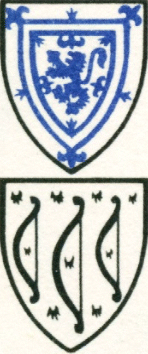

Quarters – and more quarters
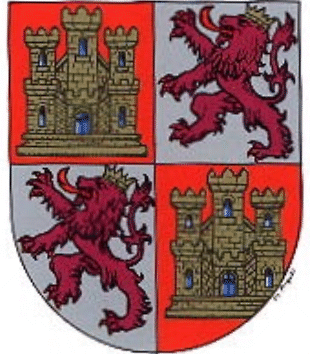
by Mike Oettle
WHEN the arms of two separate families, or two separate lordships, are combined, this requires marshalling – the combination of arms according to laid-down rules.
Some temporary examples of marshalling are the use of impalement to signify a marriage, or to show that a particular person holds a certain office. An escutcheon of pretence will be used where a wife is an heiress – marshalling consequent on marriage is mentioned in this article, while arms of office are mentioned here.
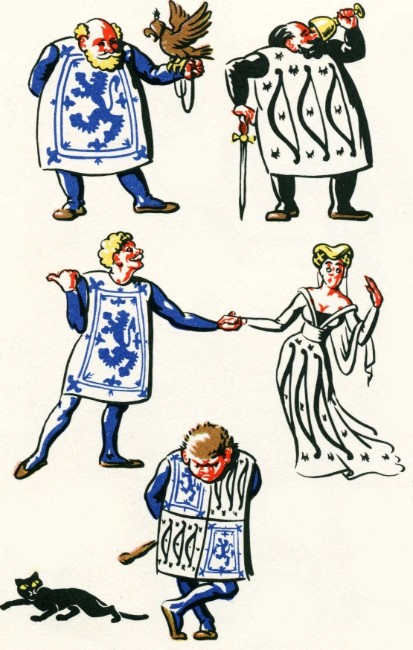
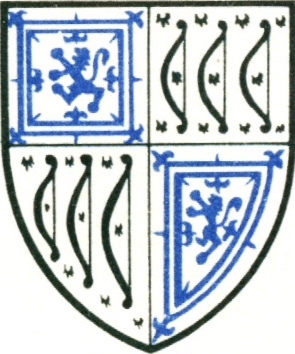
But when arms are marshalled together on a permanent basis, as a result of inheritance, this most commonly entails slicing a shield into quarters. To begin with this is a mathematical division into four, and initially only two separate coats are usually joined in this way.
The very first time two coats of arms were quartered was in the union of the kingdoms of Castile and Leon, when the canting (punning) arms of the two realms – the castle of Castile and the lion of Leon – were placed on a single shield, the gold castle on its red field in the first and fourth quarters, the purple lion on its silver field in the second and third quarters.

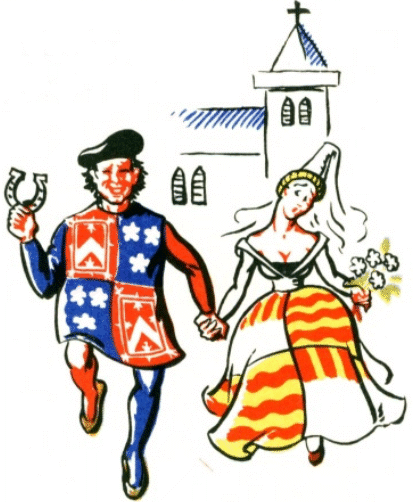
Moncreiffe and Pottinger give the example of the Bowes and Lyon families, ancestors of Elizabeth, Queen Consort to King George VI and Queen Mother from 1952 to 2002. Moncreiffe adds: “Of course if a man with no sons had several daughters, all his grandchildren could eventually ‘quarter” his arms with their own fathers’ coats.”
Quarterings, of course, don’t stop with combining just two coats.
There are four quarters (speaking mathematically) to the shield, and if there aren’t enough quarters for all the coats a man is entitled to, the term “quartering” is expanded to allow for further additions.
In Scotland, a person inheriting a coat that is already quarterly is obliged to add it to his family arms as a “grand quarter” – a quarter which is further subdivided.
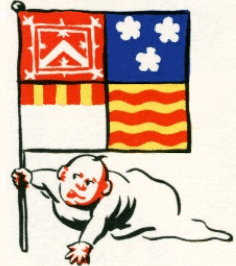

Here we have the arms of Fleming, Fraser, Keith and Drummond, already united into simple quartered coats. Then Mr Fraser-Fleming marries Miss Drummond-Keith, and their offspring quarters the four coats together.
Next comes a union between a daughter of this family and an Elphinstone, creating a coat with Elphinstone and a grand quarter of the first-mentioned four families’s arms.
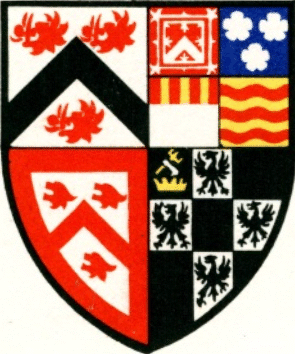
The present Lord Elphinstone happens also to be descended from Fullerton and Buller heiresses, and so quarters these two coats as well.
The length of a surname will, of course, vary in families that are able to muster quarters at this level. Some families use multiple, hyphenated names, others use only the pronominal name (that of the paternal ancestor).
In England (and other English-speaking countries), a kind of inverse snobbery has grown up where families not belonging to the aristocracy avoid the use of hyphens, while the House of Lords insists on the hyphen. When the composer Andrew Lloyd Webber was elevated to the Lords, he was obliged to use a hyphen in his title of Lord Lloyd-Webber.
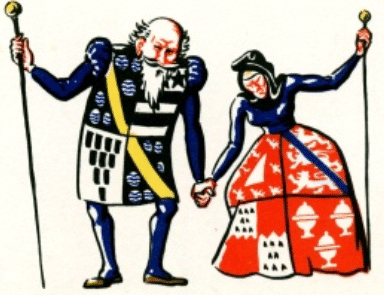

But wherever more than one name is used, the pronominal name normally appears in one of two positions: in Britain, it comes last, while on the Continent, it usually comes first. (An exception to this is the branch of the Spencer family holding the dukedom of Marlborough – which by rights ought to call itself Churchill-Spencer. Instead it uses the surname Churchill, and adds Spencer as an additional given name for its sons. A famous member of the family was Sir Winston Churchill.)
In the Iberian peninsula and in countries speaking Spanish and Portuguese, names are sometimes permanently coupled down the generations by using the word y (“and”), but frequently just two surnames are used: a man will usually be known by both his father’s and his mother’s surnames – in Spanish the paternal name comes first, and the maternal name added afterwards. In Portuguese the reverse is true, the paternal name coming last. In circumstances where only one name is used, the paternal name is preferred.
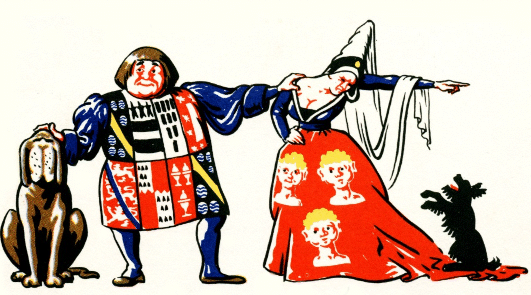
In contrast with the Scottish “grand quarters” arrangement, in England the number of quarterings simply grows. If there are three coats combined in one quartered shield, the fourth quarter repeats the first. The first quarter is usually filled by the pronominal arms, although some peers place the arms of their titles first, and persons of British royal descent entitled to quarter a version of the royal arms usually place these first. With six quarters, the sixth quarter can repeat the first.

The shield is called “quarterly of six” if there are six divisions, “quarterly of eight” if eight, and so on.
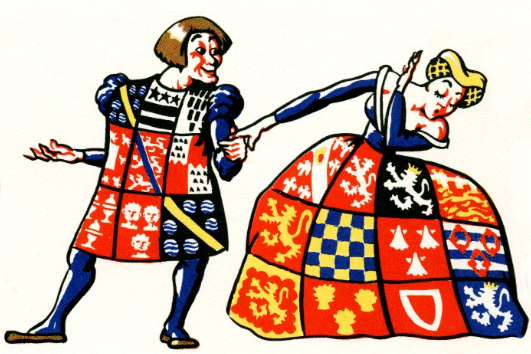
Here are further examples from Moncreiffe and Pottinger, showing how a marriage between a Stourton (with quarterings for LeMoyne and Belvale) and a Childeock (with quarterings for Fitz Payn, Fitz Warin and Argentine) produces a coat quarterly of eight. Its bearer then weds a Fauntleroy, whose son then then marries a Miss Howard – with no fewer than 12 quarterings.
The authors of Simple Heraldry modestly do not account for the elephant shown on one of their pages wearing a cloth charged with 20 quarters, but they actually had an elephant parade with such a cloth in the heraldic pageant they organised for the Festival of Britain in 1951. Moncreiffe’s text under the elephant reads:

“So many quarterings can be accumulated by an old English family during several centuries that a quarterly coat sometimes becomes so large that it would almost require an elephant to carry it.
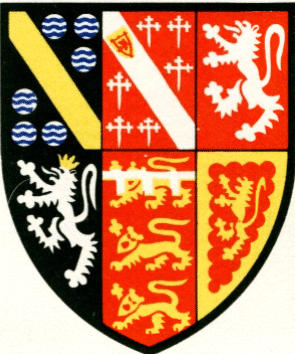
“It is not necessary to show all the accumulated quarterings, provided that junior branches show any which they use as differences to their plain family coat (where they have ‘differenced by quartering’).
“For convenience, only about half a dozen quarterings are usually shown.
“But if a quartering is shown which has descended through more than one woman, then the coats of all intervening heiresses must be shown.”
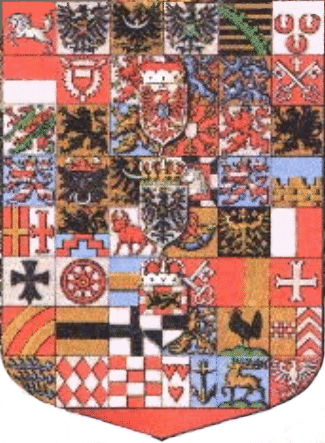
In Germany, quartering is the method used for marshalling the various lordships of an aristocratic family – and the more ancient and more powerful the family, the more the quarters. Sometimes fictitious quarters appear (often much more outrageously fictitious than the English claim to the throne of France, which was reflected in the arms of English and British sovereigns from 1340 to 1801).
The quarterings of families with a tradition as sovereign rulers – before Napoleon, Germany had more than 300 sovereign states – often include a plain field, usually red, referred to as a Regalienfeld. This is not easily translated, and is sometimes called “red for regalia” or some such silliness, but is perhaps best called “red for regality”. An alternative German name for it is Blut Fahne (literally “blood flag”, the “blood” reference being to the blood royal).
Germany is also known for the use of other methods of marshalling than quartering.
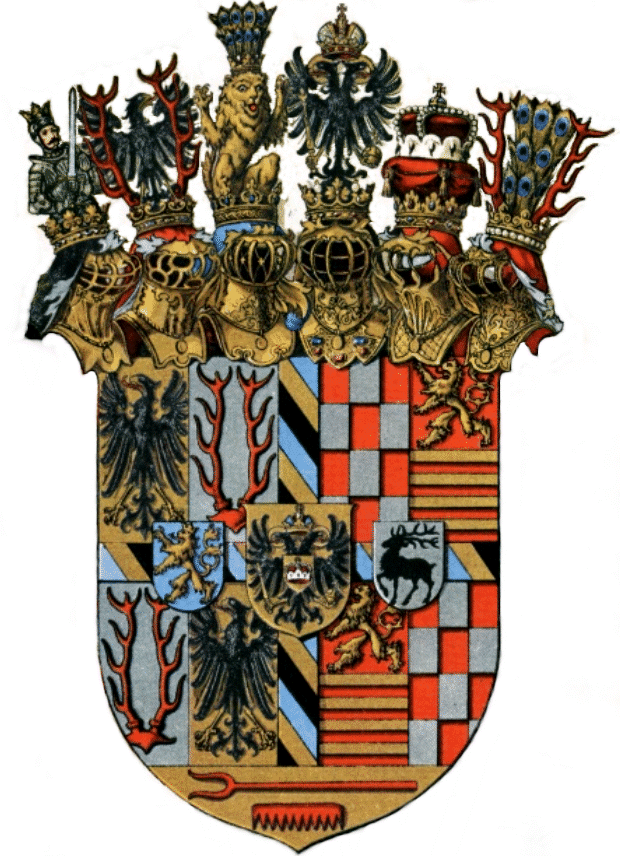
In addition to displaying quarterings, an aristocratic family might display the arms of its principal lordships, or of its principal ancestors, in an inescutcheon (or several inescutcheons), and might even bear a second, smaller inescutcheon (called a Herzschild) within an inescutcheon.
The “great arms” (shown here above left as shield only [one of 48 quarters!], but usually displayed in full with a pavilion and supporters) of the Kingdom of Prussia (before 1871) included no fewer than three inescutcheons, stacked one above the other: the top one for Brandenburg, with an electoral cap and a Herzschild (see here for an explanation); the middle one for Prussia, with a royal crown; and the lowest one for Hohenzollern, the Black Forest statelet where the royal family originated. In base (a straight-edged base) is the Regalienfeld.
Quarterings might often be displayed between the arms of a cross.
The rulers of the Fürstentum (principality) of Schwarzburg-Sondershausen (above right) displayed a Regalienfeld in base – unusually, in gold, not red (and charged with a hayfork and a horse-comb [mistakenly called a rake]) – and the (larger) middle inescutcheon of the three they displayed horizontally included a Herzschild, charged with a princely cap. Again the shield base is straight. These arms have the quarterings around a cross bendy (which does not extend into the foot) in blue, gold and black, and there are no fewer than six crests.
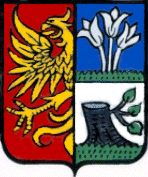
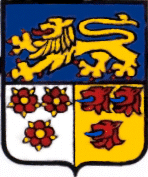
And quartering frequently does not even occur. Two coats of arms may be combined through impalement (this method is explained here), by dividing the shield per fess, or a combination of these two methods. Examples of both are given at right. When a fourth coat is added to either of these, the four might then be quartered together.
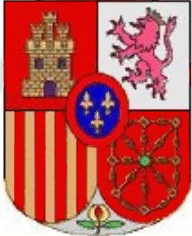
On occasion, the arms of a Continental family might be marshalled through the placement of a second coat on a bend, a canton, on a shield base or by tiercing in pile inverted. This last method gives a similar appearance to the use of a base, but allows the third coat more room. In both these instances the partition is frequently embowed. (Examples of both the bend and tiercing in pile are given in this article.) An embowed base is used in the arms of the Spanish king to show a pomegranate, symbol for the province of Granada, the last part of the peninsula to be added to the Spanish realm through the reconquista.
Also to be seen in the arms of modern Spain is a cartouche (used erroneously in place of an inescutcheon) of Borbon y Parma (the King’s family arms). Read more about cartouches here (for their use by ladies) and here (for their use by clerics).
A method popular in Spain and Portugal is the use of a border of one family’s arms around the shield of another coat. The use of borders is discussed here.
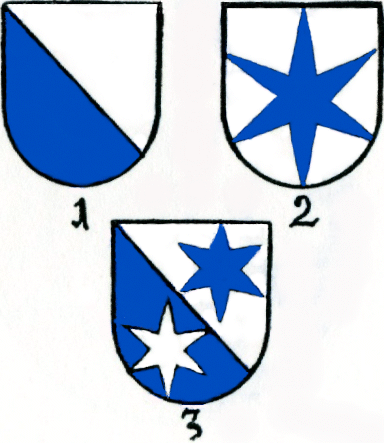
Lastly, two coats of arms might be combined by means of conjunction, where the elements of the two coats are blended. An example given by Fox-Davies is of a coat per bend argent and azure, joined with another, argent, a mullet of six points azure, where the result is a new coat per bend, argent and azure, two mullets of six points counterchanged.

Dimidiation was an early forerunner of impalement, where one half of one coat (vertically divided) was combined with the other half of another coat. English heraldry has many mediæval examples of this, for instance in the arms of the Cinque Ports (originally five ports on the Kentish coast that were responsible for defence against French invasion) where the dexter halves of the three lions of England seem to have as tails the stern ends of wooden ships.
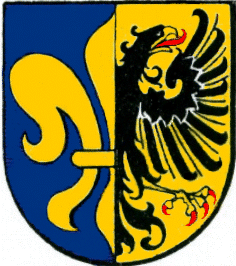
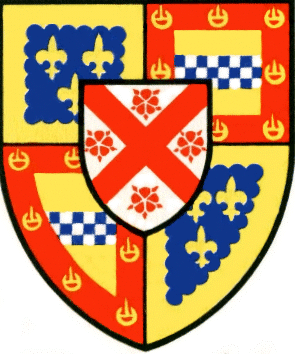
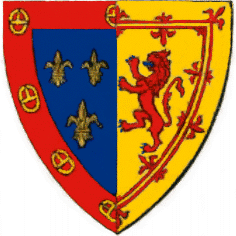
In Germany, dimidiation is still a common method of marshalling, where one or both of two coats of arms in a combination will be halved, as in the arms of Loschau.
An echo of dimidiation is to be found in the modern treatment of impaled or quartered arms, where a border or tressure will often be shown only in part, as in the arms of d’Aubigny illustrated in Boutell’s. However, these impaled arms appear to be the arms of an earlier Seigneur d’Aubigny than the one whose arms appear in Simple Heraldry, which illustrates a quartered coat with an inescutcheon (for the earldom of Lennox). Aside from the fact that the quartered arms show the borders complete in each quarter, there are two interesting differences: the French royal arms appear with a different border, while Scotland has been substituted by Stewart (with the same border that, in the earlier arms, appears on the arms of France).
Quartering is a method applying to the shield contents, but it also is a combination of arms which include one or more crests. The modern British practice is usually to display only one crest, the one belonging to the pronominal arms (the quartering representing the chief family name), but occasionally more than one has been tolerated.
In Germany, an aristocratic family might display as many as half a dozen or even more crests.
British methods of marshalling are chiefly centred on quartering, but one exception is found in instances where certain arms are inherited through the female line. This crops up where an heiress marries and has daughters, while her husband, through another marriage, will have sons. The sons inherit the paternal arms, but the heiress’s daughter or daughters indicate their inheritance through the use of cantons.
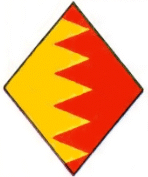
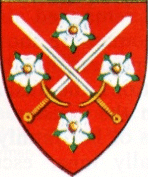

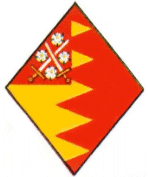
L G Pine, writing in the Encyclopædia Britannica, gives the instance of Thomas Bermingham, Earl of Louth († 1777), whose daughter Lady Mary married William St Lawrence, 2nd Earl of Howth, and had four daughters. The earl married a second time and had other children, including a son (the 3rd earl).
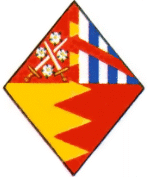
Lady Mary’s daughter Lady Isabella St Lawrence, coheir of her mother, married William Richard Annesley, 3rd Earl of Annesley, and had one daugher, Mary. The earl, like his father-in-law, married a second time and had sons (successively the 4th and 5th earls), but Lady Mary was her mother’s sole heir and coheir of her grandmother.
Lady Isabella’s arms (shown here as a lozenge, indicating her as a spinster) are given as those of Bermingham with St Lawrence in canton, while Lady Mary Annesley’s arms (also a lozenge) add the arms of Annesley in a sinister canton.

Comments, queries: Mike Oettle
